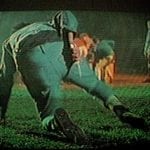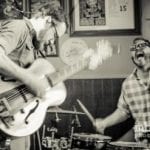“The Great Flood” is a Glowing Alternative History of the Birth of Rock n’ Roll
I have always been enamored of great floods—mostly because of the way they alter human history in unforeseen ways. Just as Katrina is still re-shaping modern New Orleans, the Mississippi River Flood of 1927 had a huge effect on American culture that we can only measure today through the remarkable impact it had on our music.
Bill Morrison, the filmmaker, and Bill Frisell, the musician, collaborated on a new project called The Great Flood, which uses archival film of the flood of ’27 and a newly composed suite of music to tell the story of that natural disaster, the worst in American history. The live music and film played late Friday night at Carnegie Hall in New York City.
In the spring of 1927, the Mississippi River broke out of its earthen embankments in 145 places and flooded 27,000 square miles. As a result, there was a forced exodus of displaced sharecroppers, who left plantation life and migrated to northern cities, adapting to an industrial society with its own set of challenges.
What they don’t teach us in school is the great migration to the north fueled the rise of acoustic blues. This included artists who survived the flood, such as Charley Patton and his High Water Everywhere, as well as Memphis Minnie and her When the Levee Breaks, which was reworked by Led Zepplin and became one of the group’s biggest hits. Bessie Smith, Barbecue Bob and Kansas Joe McCoy also wrote songs. William Faulkner’s short story Old Man was about a prison break from Parchman Penitentiary during the flood.
Several decades after the flood, Randy Newman wrote, Louisiana 1927, Zachary Richard wrote, Big River, and Eric Bibb wrote Flood Water about it. The artistic output has been significant.
Just as important, the Great Flood also helped create electric blues bands that thrived in cities like Memphis, Detroit and Chicago. This incubated modern jazz, rhythm and blues and eventually, rock & roll.


Frisell’s music was magnificent and perfectly matched the film as it told its story. It was a parade of Americana music, from roots to jazz to modern rock. A crowd pleaser was a film scan of a 1927 Sears Roebuck catalog—one where you could buy anything from to a full orchestra of musical instruments to a house.
Frisell knows this territory well. Over 35 years he done more than 250 recordings, with film scores from the original Buster Keaton films to the work of mid-century rural Arkansas photographer Mike Disfarmer. Frisell collaborated earlier with Morrison on The Film of Her and The Mesmerist.
Morrison is a master of combining archival material with original footage to create unique visual tapestries that are set to contemporary music. He has collaborated with John Adams, Laurie Anderson, Gavin Bryars, Dave Douglas, Michael Gordon, Henryk Górecki, Vijay Iyer, Jóhann Jóhannsson, David Lang, Julia Wolfe, Steve Reich and Simon Christensen. Morrison first met Frisell while working in the kitchen of the Village Vanguard in the early 1990s.







